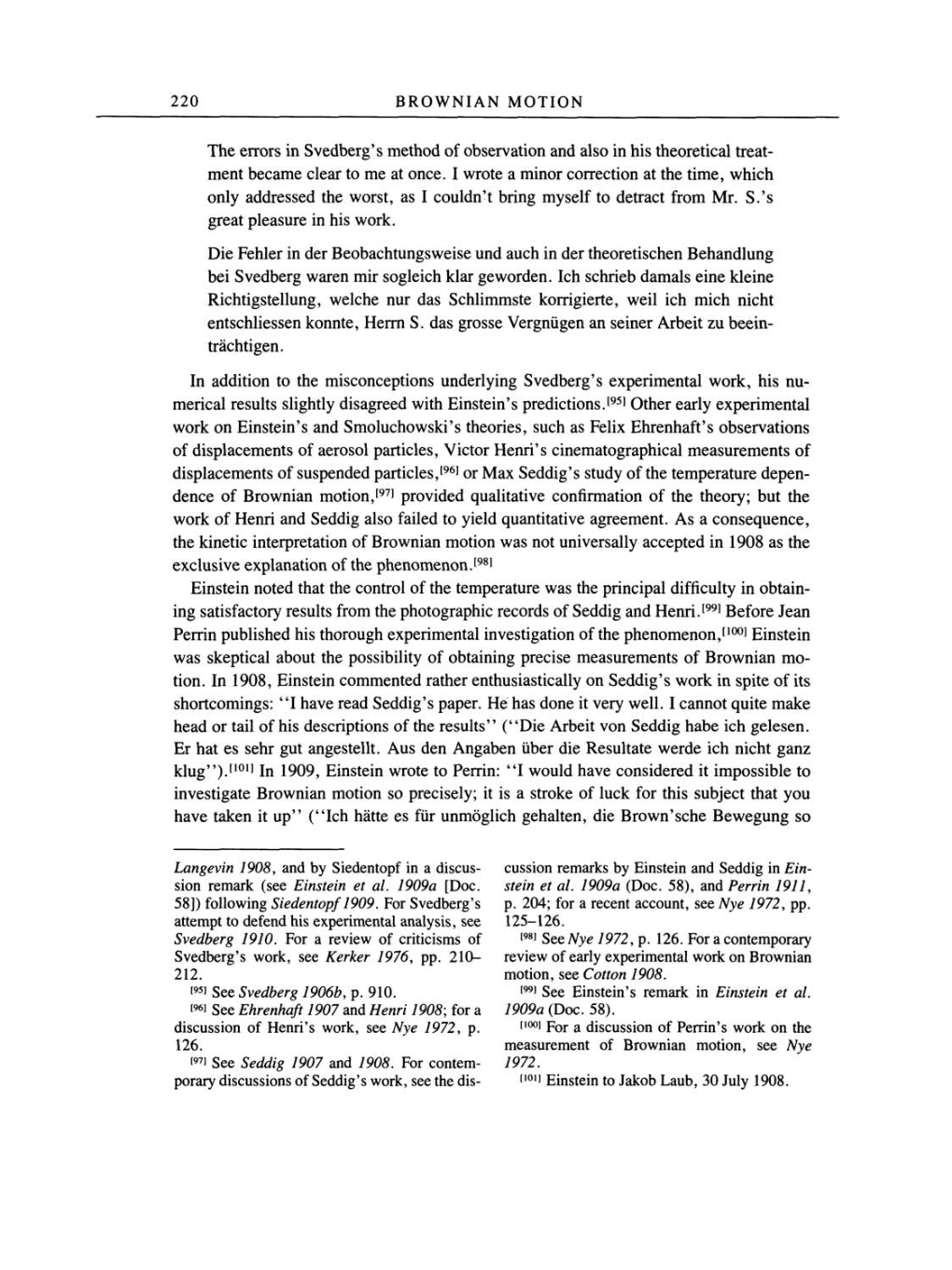220 BROWNIAN
MOTION
The
errors
in
Svedberg's
method
of
observation
and also
in his theoretical treat-
ment became
clear to
me
at
once.
I
wrote
a
minor correction at the time,
which
only
addressed the
worst, as
I
couldn't
bring
myself
to detract from
Mr.
S.'s
great pleasure
in his
work.
Die Fehler
in
der
Beobachtungsweise
und auch
in
der theoretischen
Behandlung
bei
Svedberg waren
mir
sogleich
klar
geworden.
Ich schrieb damals eine kleine
Richtigstellung,
welche
nur
das Schlimmste
korrigierte,
weil ich mich
nicht
entschliessen
konnte,
Herrn S. das
grosse Vergnügen an
seiner Arbeit
zu
beein-
trächtigen.
In addition to the
misconceptions underlying
Svedberg's experimental
work, his
nu-
merical results
slightly disagreed
with
Einstein's
predictions.[95]
Other
early
experimental
work
on
Einstein's
and
Smoluchowski's
theories,
such
as
Felix
Ehrenhaft's observations
of
displacements
of
aerosol
particles,
Victor
Henri's
cinematographical
measurements
of
displacements
of
suspended
particles,[96]
or
Max
Seddig's
study
of
the
temperature
depen-
dence
of
Brownian
motion,[97] provided qualitative
confirmation
of
the
theory;
but the
work
of
Henri and
Seddig
also failed
to
yield quantitative agreement.
As
a
consequence,
the kinetic
interpretation
of
Brownian motion
was
not
universally accepted
in 1908
as
the
exclusive
explanation
of
the
phenomenon.[98]
Einstein noted that the control
of
the
temperature was
the
principal difficulty
in obtain-
ing satisfactory
results from the
photographic
records
of
Seddig
and
Henri.[99] Before
Jean
Perrin
published
his
thorough experimental
investigation
of
the
phenomenon,[100]
Einstein
was skeptical
about the
possibility
of
obtaining precise
measurements
of Brownian
mo-
tion. In
1908,
Einstein commented rather
enthusiastically
on
Seddig's
work
in
spite
of
its
shortcomings:
"I
have read
Seddig's
paper.
He has done it
very
well. I cannot
quite
make
head
or
tail
of
his
descriptions
of
the
results"
("Die
Arbeit
von Seddig
habe ich
gelesen.
Er hat
es
sehr
gut angestellt.
Aus den
Angaben
über die Resultate werde ich nicht
ganz
klug").[101]
In
1909,
Einstein wrote
to
Perrin:
"I
would have
considered
it
impossible
to
investigate
Brownian motion
so precisely;
it
is
a
stroke
of
luck for
this
subject
that
you
have taken it up" ("Ich
hätte
es
für
unmöglich
gehalten,
die
Brown'sche
Bewegung so
Langevin 1908,
and
by
Siedentopf
in
a
discus-
sion
remark
(see
Einstein et
al.
1909a
[Doc.
58]) following
Siedentopf 1909. For Svedberg's
attempt
to
defend his
experimental analysis, see
Svedberg
1910. For
a
review
of
criticisms of
Svedberg's work, see
Kerker
1976,
pp.
210-
212.
[95]
See
Svedberg
1906b,
p.
910.
[96]
See
Ehrenhaft
1907 and
Henri
1908;
for
a
discussion
of Henri's
work,
see Nye
1972,
p.
126.
[97]
See
Seddig
1907 and 1908. For
contem-
porary
discussions
of
Seddig's work,
see
the dis-
cussion remarks
by
Einstein and
Seddig
in Ein-
stein et
al. 1909a
(Doc. 58),
and
Perrin
1911,
p. 204;
for
a
recent account,
see Nye 1972,
pp.
125-126.
[98]
See
Nye 1972,
p.
126. For
a contemporary
review
of
early experimental
work
on
Brownian
motion,
see
Cotton 1908.
[99]
See
Einstein's
remark in Einstein
et
al.
1909a
(Doc. 58).
[100]
For
a
discussion
of Perrin's
work
on
the
measurement
of
Brownian
motion,
see Nye
1972.
[101]
Einstein to Jakob
Laub,
30
July
1908.
